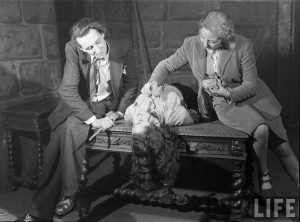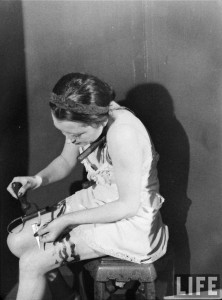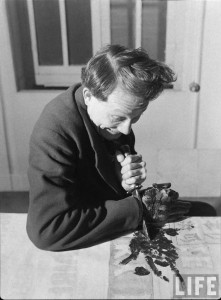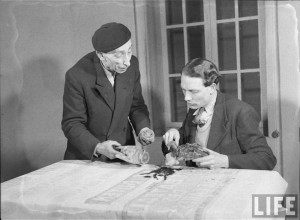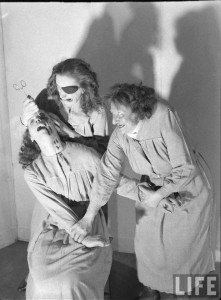(The following was originally published in The New York Times, September 4, 1910)
Busy Stage Workers the Public Never Sees
A Little Army of Them Required to Set the Scenes and Handle Mechanical Side of Every Production
There are fully 1,500 men appearing on the stage in New York every night that the audience never sees and very seldom hears one or two of them pounding cocoanut shells on board – or it may be the more modern horseshoe shaped mallets striking a smooth stone slab – and thereby suggesting the invisible presence of a galloping steed. Sometimes, too, when the music is playing softly, the audience sitting near the stage catches a rumbling sound of heavy things being moved, or hears a muffled voice or two.
But for the most part this little army of people in the profession is never seen or heard during a performance, and is almost as little appreciated as the man who pays off the actors or the artist who designs the posters.
They are the men who tie the scenery together, who bring in the furniture, who manage the lights, and pull the strings, literally, that make the houses and mountains and things stand around in their proper places. At the Hippodrome – and there, by the way, they often are seen by the audience – they are the chaps who drag the ton-weight carpets around and put up marvelous structures for the acrobats and others to stand on – the men who seem to know how to do anything. They call them “rough necks” in a circus.
Just because their union is making an effort toward an increase in pay and certain other privileges, these men have been brought to the public’s attention in the last few weeks. Since heavy sets and elaborate mechanical effects arrived the force back of the curtain line has increased to the point of having strict discipline and, according to some of those in the business, to having a pride of work. Almost without exception stagehands are interested in the success of their part of the performance nowadays, and take almost as much pride in having things right, and having them right in the shortest possible time, as the actor does in receiving a “hand” at the end of a scene.
There are four divisions of stagehands, all under the immediate direction of the stage carpenter, who is boss back of the curtain line after the stage manager, and in some things before him. There are the “grips,” who handle the scenery and nothing else; the “clearers,” who handle the movable properties, from pins to locomotives, but who will not touch a piece of scenery; the “flymen,” who take care of the ropes above the stage and whose duty it is to haul up and let down the “hung” scenery, and the electricians and “operators,” who take care of everything relating to the lighting of the stage, and in their case alone they overflow to the front of the house and look after the lighting there.
Theoretically, these divisions never overlap. A “grip” simply will not handle a “prop,” and a “clearer” may not so much as look hard at an electrical “fixture,” even though the fixture is about to fall off from its insecure attachment. If a scene has a practical fireplace, with a grate and a nice red electric light to make the fire glow, the “grips” take away the painted chimney piece, the “clearers” remove the grate, and the electricians carry away the incandescent bulb and the wire attached thereto.
There is a story told of an occasion when a portable bathtub full of water was used in one scene. The bath was a “prop,” to be handled by the “clearers.” No “grip” had any right to touch it. One night – this was on the road – the “clearers” put the tub down in a passage way leading to that particular theatre’s “scene dock,” where the “flats” not in use were slid away until needed. They forgot the tub, which was a big tin affair painted green, having completed the clearing of the stage and gone to the side door for fresh air. The “grips” went after the painted “flats” to complete the setting of the stage. One after the other they came to the tub, climbed laboriously over or around it, hauled out the scenery, lifted it over the obstacle, and climbed back again. They simply had no right to move the tub, or in any way interfere with the work of the clearers.
When specialization began to set in and stage hands became organized, there was considerable discussion as to where the duties of the various divisions ended and began. There was a dispute months long as to whether a grass mat used in an exterior scene was a “prop” or a part of the scenery, and also into which category a movable fence should come. Now everything that is used to “dress the stage” is considered a “prop”; the carpets, hangings, pictures on the wall, growing plants, real waterfalls – everything that does not belong directly to the scenery.
As soon as the curtain is down and the possibility of it going up again in response to plaudits of the multitude has disappeared, the stage hands leap to their work. The clearers began to take off the “props” of this act, through the doors first, and then through the open space left by the grips when they have begun to move the scenery. The stage is usually free of all “props” by the time all of the “flats” are down and stacked out of the way. Then the properties for the next act are brought on and put in the middle of the stage, while the setting of the walls – if it be an interior scene – is being brought out and put in place. While the walls are being built with that strange flapping sound that the audience sometimes hears from the front – that is made by the ropes used in tying the sections together – the clearers are putting the furniture in the locations suggested by the author of the play, or, more likely, by the same director.
It is all done on schedule. Every grip and every clearer knows exactly what he is to do and how he is to keep from interfering with what some one else is doing. When the order is given to “strike,” which means clear the stage for the next act, each man in the gang leaps for the particular “prop” or piece of scenery delegated to his care, and hustles it out of the way with a total disregard for the shins of whoever may be in the way. When the stage is being cleared or set it belongs to the stage hands only, and even the star of greatest magnitude has no right to be in the way. The stage manager of the company is the only person who may remain with impunity in the precincts of the mechanics’ quarters. And he stands as close as possible to the curtain line, out of the way, but where he can see what is going on, and gives whatever directions are necessary about the lowering of the “borders,” and the arranging of the scenery and props. It is the stage manager who gives the signal for the curtain to be raised after he has looked over the work of the stage hands and found it good.
The stage force in the theatres in New York averages from twenty to fifty men to each house, depending on the nature of the attraction current there. This average holds, of course, in all first-class theatres in other cities, and in most of the one-night stand places. That there are fully 1,500 men employed back of the curtain line and out of sight of the audiences in New York is somewhat within the actual figures, but it is a close approximation. This week, for example, one big musical production that has been running all Summer will end its local engagement, and the number of men at work will be reduced just that much, so far as this one theatre is concerned. On the other hand, new plays coming into the city will demand the aid of some, if not all, of these men. Of course, they are all members of the union, of the “T.M.A.,” the Theatrical Mechanics’ Association. The number of union stage hands in every city is generally in excess of the number of workers required, because there must always be enough authorized workers to take care of the largest kind of theatrical productions.
When a “road” attraction is about to arrive in a town the local stage carpenter receives a “scene plot,” sent on ahead of the company, which tells him just how many grips, how many clearers, how many fly men and electricians will be needed. He has them ready when the production arrives in town. The company carries at least a carpenter and a property man of its own, and in unusual cases, when the settings are particularly heavy or intricate, it carries several trained stage hands besides. The company carpenter has charge of the setting of the scenery, though the local stage hands are under the direction of the local carpenter. When the attraction remains for any length of time in one theatre the company carpenter sometimes turns over the entire stage to the local man after the play has been given for several performances.
In the case of a “New York production,” when the play is coming in for a hoped-for long run, the stage force is rehearsed for the opening performance. Before the “first night” three or four scene and light rehearsals are given for the purpose of familiarizing the crew with the scenery and the running of the play, and then a further rehearsal at the time of the final full company dress rehearsal, immediately before the play opens. When the attraction opens out of town a short time, before coming into the city is usually the custom to take at least a part of the crew to the other city, so that they may have the scenic side of the play down pat by the time it comes to New York.
One large musical comedy now running on Broadway may be taken as an example of how the force is divided and how many people are needed. This play has two or three heavy sets, and also requires several quick changes of scenery. Its stage crew consists of a head carpenter and assistant, seventeen “grips,” head property man and his assistant and seventeen “clearers,” six flymen, two chief electricians, and fourteen “operators,” or assistant electricians, which does not include four men on electrical duty in the front of the house – sixty in all. The record for setting the heaviest scene complete is thirty seconds. At the Hippodrome the force runs well past 100, with the proportion of the “clearers” much greater.
The “clearers” it must be remembered, are responsible not only for the movable scenery on the stage, but for the things the actors and chorus people carry in their hands. In the musical play mentioned it was found necessary to give each “clearer” a number, plainly displayed on his cap, so that the members of the company could recognize the man from whom each was to receive his or her “prop.” At the Hippodrome, where sometimes as many as 1,000 “props” are required for one scene, such as the ballets, there is a real army of “clearers” on duty. One division gives out the “head props,” such as helmets and fancy head dresses that do not form an integral part of the costumes, and another division has charge of the “hand props,” which consist of spears, guns, wands, baskets of flowers – everything that is to be carried in the hand.
In vaudeville there are different laws and different customs, after the general rules of the union. There each of the seven or eight acts on the bill is a company in itself, with different scenic and property requirements. The principal member of the “act” is supposed to pay for the special work done for his part of the programme, outside of the necessary moving of scenery and handling of staple “props.” The payment is generally done in the form of gratuities at the end of the week’s engagement, and the average performer is usually very glad to do the paying. In vaudeville a property man or a “grip” while attending strictly to his business can often cause a performer considerable annoyance – “crab the act” according to the vernacular – and by a slight zeal beyond his actual duties he can add much to the success of the actor. Vaudeville stage hands, too, frequently have a chance to play parts.
Stage hands are recognized as good authorities on plays. The head carpenter’s prophesy at the end of a first performance is usually worth listening to, and it is not often that the property man makes a mistake. And after two weeks of an attraction there is not a stage hand in the theatre who does not feel that he could play any part in the piece. Not as the vaudeville stage hand plays parts, by being the butt of the comic juggler’s comedy or coming on as a bellboy or a waiter, but as the actor plays them, only in the stage hand’s own mind, a good deal better.
Sometimes they try it. One Christmas time the stage hands at the Belasco Theatre, which is now the Republic, put on a burlesque of “The Rose of the Rancho” for Mr. Belasco’s benefit, and surprised the “governor” and the other invited guests by their histrionic ability. And last Spring, at a performance given for the Hippodrome Sick Benefit Fund, the stage crew from the Bijou gave an act of “The Lottery Man” so well that the regular company began to be worried.
Many of the workers on the stage “hold down” other jobs. They are required only six nights and two afternoons during the week, except when scene rehearsals are called. Almost any daylight occupation can be attended to without interference with the work at night. A very incomplete census of the stage hands in town indicates that a good proportion of them are married. At one big house they have got into the habit of marrying members of the chorus, and one of the happiest of the big force over there this season is a “clearer” who was excused from rehearsals one day last week to go home and see the new baby. Last Winter its mother was one of those who went down into the water and astonished out-of-town visitor by not coming up again.
– first published in The New York Times – September 4, 1910


